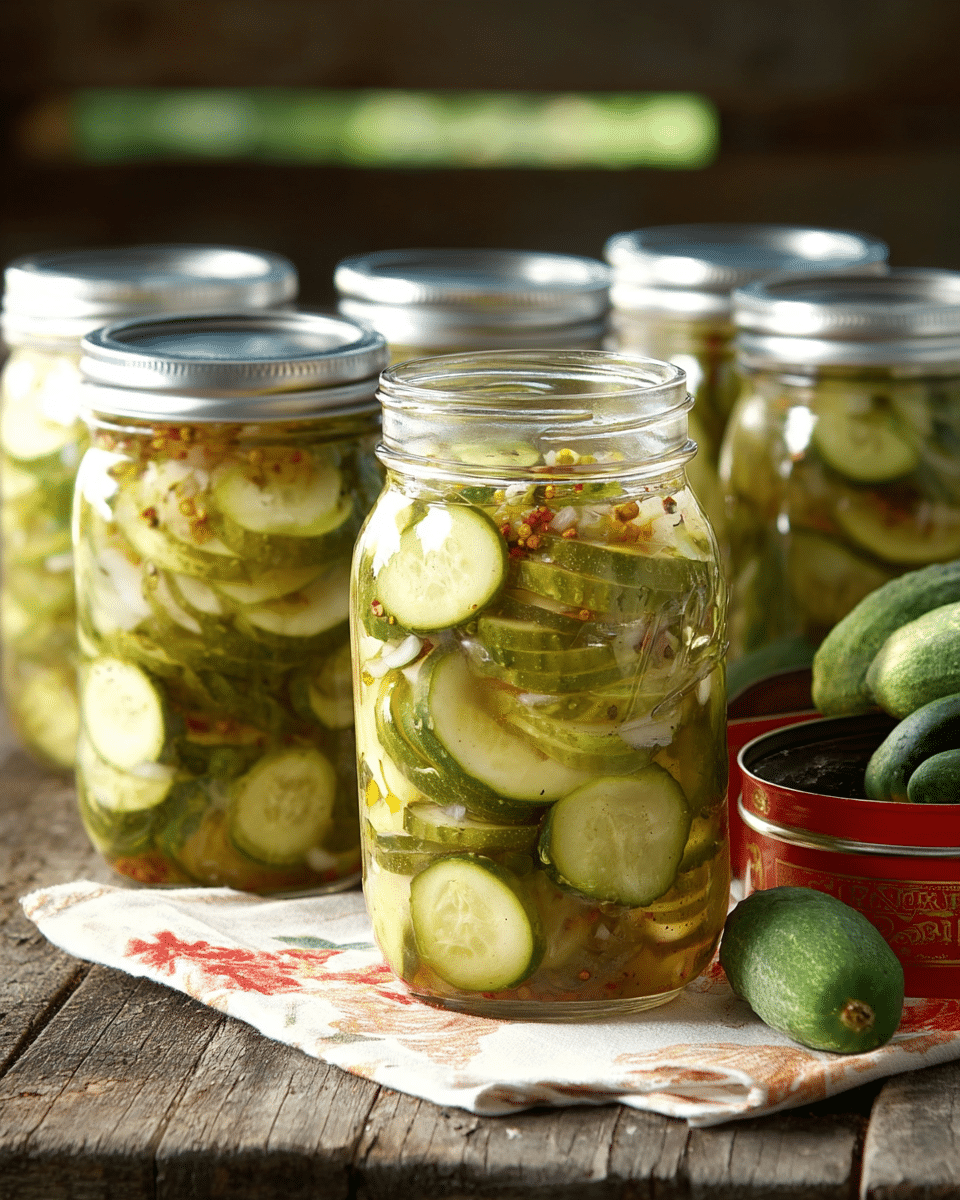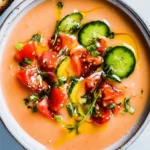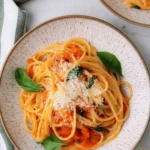Old-Fashioned Bread and Butter Pickles are a timeless favorite, beloved for their perfect balance of sweet and tangy flavors. These crunchy cucumber slices are typically served as a side, sandwich topping, or snack and have been a staple in American kitchens for generations. Made with a simple vinegar brine infused with sugar, onions, mustard seeds, and turmeric, these pickles are both easy to make and deeply satisfying. Their vibrant yellow hue and punchy taste bring a nostalgic charm to any table, reminding many of cherished family recipes and summer harvests.
FULL RECIPE
Ingredients
- 6 cups thinly sliced cucumbers (about 4–5 medium cucumbers)
- 1 cup thinly sliced onion
- 1/4 cup kosher salt
- 2 cups apple cider vinegar
- 1 1/2 cups granulated sugar
- 1 tablespoon mustard seeds
- 1/2 teaspoon celery seeds
- 1/2 teaspoon ground turmeric
- 1/2 teaspoon crushed red pepper flakes (optional)
- Ice (for soaking)
Directions
- In a large bowl, combine the sliced cucumbers and onions. Sprinkle with kosher salt and toss to coat evenly.
- Add enough ice on top of the cucumber-onion mixture to cover it, then let it sit for 1–2 hours. This step helps keep the pickles crisp.
- After soaking, drain and rinse the cucumbers and onions under cold water. Set aside.
- In a large non-reactive pot, combine the apple cider vinegar, sugar, mustard seeds, celery seeds, turmeric, and red pepper flakes (if using).
- Bring the mixture to a boil over medium heat, stirring occasionally to dissolve the sugar.
- Add the drained cucumbers and onions to the pot and return the mixture to a near-boil (do not fully boil to avoid overcooking the cucumbers).
- Remove the pot from heat.
- Ladle the hot pickles and brine into sterilized jars, leaving about 1/2 inch of headspace.
- Seal the jars with lids and allow them to cool to room temperature. Store in the refrigerator for up to 2 months, or process in a water bath canner for long-term shelf storage.
- Let the pickles rest for at least 24 hours before serving for the best flavor.
Nutrition Facts
- Calories: 60
- Total Fat: 0g
- Saturated Fat: 0g
- Cholesterol: 0mg
- Sodium: 420mg
- Total Carbohydrates: 15g
- Dietary Fiber: 1g
- Sugars: 14g
- Protein: 0g
- Vitamin A: 2% DV
- Vitamin C: 4% DV
- Calcium: 1% DV
- Iron: 2% DV
Flavor Profile and Texture
Old-fashioned bread and butter pickles are celebrated for their harmonious blend of sweet, tangy, and subtly spiced flavors. Unlike dill pickles, which lean more toward the sour end of the spectrum, bread and butter pickles are sweeter due to the addition of sugar in the brine. The apple cider vinegar adds a pleasant acidity, while mustard seeds, turmeric, and optional red pepper flakes offer warmth and complexity. Texturally, the pickles should remain slightly crisp after processing, delivering a satisfying snap with every bite. The addition of onions adds a soft counterpoint and an aromatic depth that complements the pickles’ vibrant flavor.
Health Benefits of Homemade Pickles
While pickles are often seen as a condiment or snack, they offer a surprising array of health benefits, especially when made at home. Cucumbers are naturally hydrating and low in calories, making them a healthy base. Vinegar, especially apple cider vinegar, has been linked to improved digestion and blood sugar regulation. The spices used in bread and butter pickles—particularly turmeric—contain antioxidants and anti-inflammatory properties. Making them at home also means avoiding preservatives and artificial additives found in many store-bought options, leading to a cleaner, more natural product with better control over sodium and sugar content.
Best Cucumber Varieties for Pickling
Not all cucumbers are created equal when it comes to pickling. For traditional bread and butter pickles, small, firm pickling cucumbers—often called Kirby cucumbers—are ideal. These cucumbers have thin skins, small seeds, and a firm interior that holds up well to slicing and soaking in brine. Their structure allows them to remain crisp even after processing, which is crucial for the desired texture of bread and butter pickles. While slicing cucumbers can be used in a pinch, they tend to become softer and may have a bitter peel, which could affect the final flavor and texture.
Customizing the Spice Blend
One of the joys of making homemade bread and butter pickles is the ability to customize the flavor profile to suit personal tastes. While traditional recipes call for mustard seeds, turmeric, celery seeds, and sometimes red pepper flakes, these ingredients can be adjusted or expanded. For a spicier version, you can add sliced jalapeños, black peppercorns, or more red pepper flakes. For a more aromatic touch, try incorporating cloves, cinnamon sticks, or a bay leaf. The flexibility in seasoning allows for creative experimentation and the development of a house-style pickle unique to each cook’s preference.
Pairing Ideas and Serving Suggestions
Bread and butter pickles are incredibly versatile and can be served in a variety of ways. They make an excellent addition to sandwiches, burgers, and wraps, offering a burst of sweetness and crunch that balances savory ingredients. Add them to cheese boards, charcuterie platters, or deviled eggs for a tangy accent. Chop them finely and stir them into potato salad, coleslaw, or tartar sauce for added flavor. For an old-school snack, simply serve them chilled alongside crackers and sharp cheddar. Their balanced taste complements both rich and mild dishes, making them a welcome component on nearly any plate.
Storage and Shelf Life
Proper storage is essential to maintaining the quality and safety of homemade pickles. When stored in sterilized, sealed jars and refrigerated, quick-pickled bread and butter pickles can last for up to two months. If processed in a water bath canner, the jars can be stored in a cool, dark pantry for up to a year. It’s important to always check for signs of spoilage—such as cloudiness, off smells, or bulging lids—before consuming. Once opened, jars should be kept in the refrigerator and consumed within four weeks for optimal taste and texture.
Tips for Maintaining Crispness
Crispness is one of the most desirable qualities in bread and butter pickles, and there are several ways to preserve it. First, soaking sliced cucumbers in ice and salt before pickling helps draw out moisture and firm up the texture. Choosing small, firm cucumbers is another critical factor. Some recipes also include a small amount of calcium chloride, a firming agent approved for pickling, which helps prevent softening. Avoid overcooking the cucumbers during the heating process; instead, heat them just until they begin to soften slightly. These steps ensure your pickles retain that satisfying crunch.
Scaling the Recipe for Larger Batches
Whether you’re preserving a summer garden harvest or making gifts for family and friends, bread and butter pickles are easily scalable. Doubling or tripling the recipe is simple, as long as you maintain the proper ratio of vinegar to sugar and salt to ensure safety and flavor balance. It’s helpful to prep all your vegetables and spices ahead of time and use a large pot for brining and heating. Be sure to have enough sterilized jars ready and consider labeling them with the date and flavor notes. Making large batches can be an efficient and rewarding way to stock your pantry for the months ahead.
Using the Leftover Brine
The flavorful brine left over from a jar of bread and butter pickles should never go to waste. It can be reused to quick-pickle other vegetables such as onions, carrots, or green beans. It also works as a tangy addition to marinades for meats or tofu, salad dressings, or potato salads. Some people even enjoy adding a splash of brine to cocktails, like Bloody Marys or picklebacks. Because it’s already seasoned and acidic, the brine can enhance many dishes with little effort, reducing waste while amplifying flavor in creative ways.
Advertisement
Conclusion
Old-fashioned bread and butter pickles are more than just a nostalgic treat—they’re a celebration of simple ingredients, time-honored techniques, and big flavor in a small package. With their perfect balance of sweet and tangy, these homemade pickles offer a crunchy, colorful addition to nearly any meal. From the joy of making them in your own kitchen to the satisfaction of customizing the spices and using every last drop of brine, bread and butter pickles embody the essence of thoughtful, flavorful cooking. Whether you’re a seasoned canner or a first-time pickler, this recipe offers an easy, rewarding way to preserve the taste of summer all year long.






